The Principle of Maximal Simplicity for Modular Inorganic Crystal Structures
Abstract
:1. Introduction
2. Methodology
3. Structures Built from 0D Modules: The Lovozerite Family
4. Structures Built from 1D Modules: Biopyriboles
5. Structures Built from 2D Modules: Spinelloids and the Kurchatovite Family
5.1. Spinelloids
5.2. Kurchatovite Family
| I (+B’)(+B”)(+B’) | V (+B”)(+B’)(−B’) |
| II (−B’)(−B”)(−B’) | VI (−B’)(+B’)(+B”) |
| III (+B”)(+B’)(+B”) | VII (−B”)(−B’)(+B’) |
| IV (−B”)(−B’)(−B”) | VIII (+B’)(−B’)(−B”) |
6. The Principle of Maximal Simplicity (Minimal Information)
7. Concluding Remarks
Funding
Acknowledgments
Conflicts of Interest
References
- Schlosser, G.; Wagner, D.P. (Eds.) Modularity in Development and Evolution; University of Chicago Press: Chicago, IL, USA, 2004. [Google Scholar]
- Callebaut, W.; Raskin-Gutman, D. (Eds.) Modularity: Understanding the Development and Evolution of Natural Complex Systems; MIT Press: Cambridge, MA, USA, 2005. [Google Scholar]
- Taylor, W.H.; West, J. The crystal structure of the chondrodite series. Proc. R. Soc. London. Ser. A Math. Phys. Sci. 1928, 117, 517–532. [Google Scholar] [CrossRef]
- Ferraris, G.; Makovicky, E.; Merlino, S. Crystallography of Modular Materials; Oxford University Press (OUP): Oxford, UK, 2008. [Google Scholar]
- Thompson, J.B. Biopyriboles and polysomatic series. Am. Mineral. 1978, 63, 239–249. [Google Scholar]
- Veblen, D.R. Polysomatism and polysomatic series: A review and applications. Am. Mineral. 1991, 76, 801–826. [Google Scholar]
- Merlino, S.; Zvyagin, B.B. Modular features of sapphirine-type structures. Z. Kristallogr. Cryst. Mater. 1998, 213, 513–521. [Google Scholar] [CrossRef]
- Zvyagin, B.B.; Merlino, S. The pyroxene-spinel polysomatic system. Z. Krist.-Cryst. Mater. 2003, 218, 210–220. [Google Scholar] [CrossRef]
- Ferraris, G.; Gula, A. Polysomatic aspects of microporous minerals—Heterophyllosilicates, palysepioles and rhodesite-related structures. Rev. Mineral. Geochem. 2005, 57, 69–104. [Google Scholar] [CrossRef]
- Ferraris, G. Modular structures—The paradigmatic case of the heterophyllosilicates. Z. Krist.-Cryst. Mater. 2008, 223, 76–84. [Google Scholar] [CrossRef]
- Nespolo, M.; Aroyo, M.I. The modular structure of pyroxenes. Eur. J. Miner. 2016, 28, 189–203. [Google Scholar] [CrossRef]
- Nespolo, M.; Bouznari, K. Modularity of crystal structures: A unifying model for the biopyribole–palysepiole series. Eur. J. Miner. 2017, 29, 369–383. [Google Scholar] [CrossRef]
- Makovicky, E. The building principles and classification of bismuth-lead sulphosalts and related compounds. Fortschr. Miner. 1981, 59, 137–190. [Google Scholar]
- Makovicky, E. The building principles and classification of sulphosalts based on the SnS archetype. Fortschr. Miner. 1985, 63, 45–89. [Google Scholar]
- Makovicky, E. Rod-based sulphosalt structures derived from the SnS and PbS archetypes. Eur. J. Miner. 1993, 5, 545–592. [Google Scholar] [CrossRef]
- Skowron, A.; Brown, I.D. Crystal chemistry and structures of lead–antimony sulfides. Acta Crystallogr. Sect. B Struct. Sci. 1994, 50, 524–538. [Google Scholar] [CrossRef]
- Makovicky, E. Modular crystal chemistry of sulphosalts and other complex sulphides. In Modular Aspects of Minerals; Mineralogical Society of Great Britain and Ireland: Middlesex, UK, 1997; pp. 237–271. [Google Scholar] [CrossRef]
- Makovicky, E. Modular Crystal Chemistry of Thallium Sulfosalts. Minerals 2018, 8, 478. [Google Scholar] [CrossRef] [Green Version]
- Neuhausen, C.; Rocker, F.; Tremel, W. Modular metal chalcogenide chemistry: Secondary building blocks as a basis of the silicate-type framework structure of CsLiU(PS4)2. Z. Anorg. Allg. Chem. 2012, 638, 405–410. [Google Scholar] [CrossRef]
- Cook, N.J.; Ciobanu, C.; Liu, W.; Slattery, A.; Wade, B.P.; Mills, S.J.; Stanley, C.J. Polytypism and Polysomatism in Mixed-Layer Chalcogenides: Characterization of PbBi4Te4S3 and Inferences for Ordered Phases in the Aleksite Series. Minerals 2019, 9, 628. [Google Scholar] [CrossRef] [Green Version]
- Cook, N.J.; Ciobanu, C.L.; Slattery, A.D.; Wade, B.P.; Ehrig, K. The Mixed-Layer Structures of Ikunolite, Laitakarite, Joséite-B and Joséite-A. Minerals 2021, 11, 920. [Google Scholar] [CrossRef]
- Hejny, C.; Armbruster, T. Polysomatism in högbomite: The crystal structures of 10T, 12H, 14T, and 24R polysomes. Am. Mineral. 2002, 87, 277–292. [Google Scholar] [CrossRef]
- Armbruster, T. Revised nomenclature of högbomite, nigerite, and taaffeite minerals. Eur. J. Mineral. 2002, 14, 389–395. [Google Scholar] [CrossRef] [Green Version]
- David, R.; Pautrat, A.; Kabbour, H.; Sturza, M.; Curelea, S.; André, G.; Pelloquin, D.; Mentré, O. BaCoO3n[BaCo8O11] modular intergrowths: Singularity of the n = 2 term. Chem. Mater. 2011, 23, 5191–5199. [Google Scholar] [CrossRef]
- Armbruster, T.; Lazić, B.; Reznitsky, L.Z.; Sklyarov, E.V. Kyzylkumite, Ti2V3+O5(OH): New structure type, modularity and revised formula. Miner. Mag. 2013, 77, 33–44. [Google Scholar] [CrossRef]
- Pakhomova, A.S.; Krivovichev, S.V.; Yudintsev, S.V.; Stefanovsky, S.V. Polysomatism and structural complexity: Structure model for murataite-8C, a complex crystalline matrix for the immobilization of high-level radioactive waste. Eur. J. Miner. 2016, 28, 205–214. [Google Scholar] [CrossRef]
- Kahlenberg, V.; Krüger, H.; Tribus, M. Structural systematics of SFCA-I type solid-solutions in the system CaO–Fe2O3–FeO–Al2O3. Phys. Chem. Miner. 2021, 48, 1–15. [Google Scholar] [CrossRef]
- Meng, D.; Wu, X.; Han, Y.; Meng, X. Polytypism and microstructures of the mixed-layer member B2S, CaCe3(CO3)4F3 in the bastnaesite-(Ce)–synchysite-(Ce) series. Earth Planet. Sci. Lett. 2002, 203, 817–828. [Google Scholar] [CrossRef]
- Siidra, O.; Nekrasova, D.; Depmeier, W.; Chukanov, N.; Zaitsev, A.; Turner, R. Hydrocerussite-related minerals and materials: Structural principles, chemical variations and infrared spectroscopy. Acta Crystallogr. Sect. B Struct. Sci. Cryst. Eng. Mater. 2018, 74, 182–195. [Google Scholar] [CrossRef]
- Capitani, G. HRTEM investigation of bastnäsite–parisite intergrowths from Mount Malosa (Malawi): Ordered sequences, polysomatic faults, polytypic disorder, and a new parisite-(Ce) polymorph. Eur. J. Mineral. 2019, 31, 429–442. [Google Scholar] [CrossRef]
- Capitani, G. Synchysite-(Ce) from Cinquevalli (Trento, Italy): Stacking Disorder and the Polytypism of (Ca,REE)-Fluorcarbonates. Minerals 2020, 10, 77. [Google Scholar] [CrossRef] [Green Version]
- Yamnova, N.A.; Zubkova, N.; Dimitrova, O.V.; Mochenova, N.N. Crystal structure of a new synthetic calcium pentaborate, Ca2[B5O8(OH)]2 · [B(OH)3] · H2O, and modular crystal chemistry of pentaborates with polar boron-oxygen layers. Crystallogr. Rep. 2009, 54, 800–813. [Google Scholar] [CrossRef]
- Pankova, Y.A.; Krivovichev, S.V.; Pekov, I.V.; Grew, E.S.; Yapaskurt, V.O. Kurchatovite and Clinokurchatovite, Ideally CaMgB2O5: An Example of Modular Polymorphism. Minerals 2018, 8, 332. [Google Scholar] [CrossRef] [Green Version]
- Galuskin, E.V.; Gfeller, F.; Armbruster, T.; Galuskina, I.O.; Vapnik, Y.; Murashko, M.; Włodyka, R.; Dzierzanowski, P. New minerals with a modular structure derived from hatrurite from the pyrometamorphic Hatrurim Complex. Part I. Nabimusaite, KCa12(SiO4)4(SO4)2O2F, from larnite rocks of Jabel Harmun, Palestinian Autonomy, Israel. Mineral. Mag. 2015, 79, 1061–1072. [Google Scholar] [CrossRef]
- Gorelova, L.A.; Vergasova, L.P.; Krivovichev, S.V.; Avdontseva, E.Y.; Moskaleva, S.V.; Karpov, G.A.; Filatov, S.K. Bubnovaite, K2Na8 Ca(SO4)6, a new mineral species with modular structure from the Tolbachik volcano, Kamchatka peninsula, Russia. Eur. J. Miner. 2016, 28, 677–686. [Google Scholar] [CrossRef]
- Galuskin, E.V.; Gfeller, F.; Galuskina, I.O.; Armbruster, T.; Krzątała, A.; Vapnik, Y.; Kusz, J.; Dulski, M.; Gardocki, M.; Gurbanov, A.G.; et al. New minerals with a modular structure derived from hatrurite from the pyrometamorphic rocks. Part III. Gazeevite, BaCa6(SiO4)2(SO4)2O, from Israel and the Palestine Autonomy, South Levant, and from South Ossetia, Greater Caucasus. Miner. Mag. 2017, 81, 499–513. [Google Scholar] [CrossRef]
- Galuskina, I.O.; Gfeller, F.; Galuskin, E.V.; Armbrüster, T.; Vapnik, Y.; Dulski, M.; Gardocki, M.; Jeżak, L.; Murashko, M. New minerals with modular structure derived from hatrurite from the pyrometamorphic rocks. Part IV: Dargaite, BaCa12(SiO4)4(SO4)2O3, from Nahal Darga, Palestinian Autonomy. Miner. Mag. 2018, 83, 81–88. [Google Scholar] [CrossRef]
- Rashevsky, N. Life, information theory, and topology. Bull. Math. Biophys. 1955, 17, 229–235. [Google Scholar] [CrossRef]
- Trucco, E. A note on the information content of graphs. Bull. Math. Biol. 1956, 18, 129–135. [Google Scholar] [CrossRef]
- Bonchev, D.; Rouvray, D.H. (Eds.) Complexity in Chemistry, Biology, and Ecology; Springer: New York, NY, USA, 2005. [Google Scholar]
- Chung, S.J.; Hahn, T.; Klee, W.E. Nomenclature and generation of three-periodic nets: The vector method. Acta Crystallogr. Sect. A Found. Crystallogr. 1984, 40, 42–50. [Google Scholar] [CrossRef] [Green Version]
- Klee, W.E. Crystallographic nets and their quotient graphs. Cryst. Res. Technol. 2004, 39, 959–968. [Google Scholar] [CrossRef]
- Krivovichev, S. Topological complexity of crystal structures: Quantitative approach. Acta Crystallogr. Sect. A Found. Crystallogr. 2012, 68, 393–398. [Google Scholar] [CrossRef] [PubMed]
- Krivovichev, S. Structural complexity of minerals: Information storage and processing in the mineral world. Miner. Mag. 2013, 77, 275–326. [Google Scholar] [CrossRef]
- Olds, T.A.; Plášil, J.; Kampf, A.R.; Simonetti, A.; Sadergaski, L.R.; Chen, Y.-S.; Burns, P.C. Ewingite: Earth’s most complex mineral. Geology 2017, 45, 1007–1010. [Google Scholar] [CrossRef]
- Krivovichev, S.V.; Hawthorne, F.C.; Williams, P.A. Structural complexity and crystallization: The Ostwald sequence of phases in the Cu2(OH)3Cl system (botallackite–atacamite–clinoatacamite). Struct. Chem. 2016, 28, 153–159. [Google Scholar] [CrossRef]
- Plášil, J. Mineralogy, Crystallography and Structural Complexity of Natural Uranyl Silicates. Minerals 2018, 8, 551. [Google Scholar] [CrossRef] [Green Version]
- Plášil, J. Structural complexity of uranophane and uranophane-β: Implications for their formation and occurrence. Eur. J. Miner. 2018, 30, 253–257. [Google Scholar] [CrossRef]
- Plášil, J. Uranyl-oxide hydroxy-hydrate minerals: Their structural complexity and evolution trends. Eur. J. Miner. 2018, 30, 237–251. [Google Scholar] [CrossRef]
- Plášil, J.; Petříček, V.; Majzlan, J. A commensurately modulated structure of parabutlerite, FeIIISO4(OH)·2H2O. Acta Crystallogr. Sect. B Struct. Sci. Cryst. Eng. Mater. 2017, 73, 856–862. [Google Scholar] [CrossRef] [PubMed]
- Huskić, I.; Novendra, N.; Lim, D.-W.; Topić, F.; Titi, H.M.; Pekov, I.V.; Krivovichev, S.V.; Navrotsky, A.; Kitagawa, H.; Friščić, T. Functionality in metal-organic framework minerals: Proton conductivity, stability and potential for polymorphism. Chem. Sci. 2019, 10, 4923–4929. [Google Scholar] [CrossRef] [Green Version]
- Gurzhiy, V.V.; Kuporev, I.V.; Kovrugin, V.M.; Murashko, M.N.; Kasatkin, A.V.; Plášil, J. Crystal Chemistry and Structural Complexity of Natural and Synthetic Uranyl Selenites. Crystals 2019, 9, 639. [Google Scholar] [CrossRef] [Green Version]
- Gurzhiy, V.V.; Plášil, J. Structural complexity of natural uranyl sulfates. Acta Crystallogr. Sect. B Struct. Sci. Cryst. Eng. Mater. 2019, 75, 39–48. [Google Scholar] [CrossRef] [Green Version]
- Majzlan, J. Processes of metastable-mineral formation in oxidation zones and mine waste. Miner. Mag. 2020, 84, 367–375. [Google Scholar] [CrossRef] [Green Version]
- Krivovichev, S.V.; Krivovichev, V.G. The Fedorov–Groth law revisited: Complexity analysis using mineralogical data. Acta Crystallogr. Sect. A Found. Adv. 2020, 76, 429–431. [Google Scholar] [CrossRef]
- Krivovichev, S.V. Feldspar polymorphs: Diversity, complexity, stability. Zap. RMO Proc. Russ. Miner. Soc. 2020, 149, 16–66. [Google Scholar] [CrossRef]
- Hornfeck, W. On an extension of Krivovichev’s complexity measures. Acta Crystallogr. Sect. A Found. Adv. 2020, 76, 534–548. [Google Scholar] [CrossRef] [PubMed]
- Zolotarev, A.A.; Krivovichev, S.V.; Cámara, F.; Bindi, L.; Zhitova, E.S.; Hawthorne, F.; Sokolova, E. Extraordinary structural complexity of ilmajokite: A multilevel hierarchical framework structure of natural origin. IUCrJ 2020, 7, 121–128. [Google Scholar] [CrossRef] [Green Version]
- Krivovichev, S.V. Structural complexity and configurational entropy of crystalline solids. Acta Crystallogr. Sect. B Struct. Sci. Cryst. Eng. Mater. 2016, 72, 274–276. [Google Scholar] [CrossRef]
- Kaußler, C.; Kieslich, G. crystIT: Complexity and configurational entropy of crystal structures via information theory. J. Appl. Crystallogr. 2021, 54, 306–316. [Google Scholar] [CrossRef]
- Gray, C.; Karl, G.; Novikov, V. The Four Variational Principles of Mechanics. Ann. Phys. 1996, 251, 1–25. [Google Scholar] [CrossRef]
- Penfield, S.L.; Howe, W.T.H., IV. Ueber die chemische Zusammensetzung des Chondrodits, Humits und Klinohumits. Z. Krist.-Cryst. Mater. 1894, 23, 78–98. [Google Scholar] [CrossRef]
- Barlow, W.; Pope, W.J. CLXVIII—A development of the atomic theory which correlates chemical and crystalline structure and leads to a demonstration of the nature of valency. J. Chem. Soc. Trans. 1906, 89, 1675–1744. [Google Scholar] [CrossRef] [Green Version]
- Bragg, W.L.; Brown, G.B. XXX. Die Struktur des Olivins. Z. Kristallogr. 1926, 63, 538–556. [Google Scholar] [CrossRef]
- Krivovichev, S.V. Which inorganic structures are the most complex? Angew. Chem. Int. Ed. 2014, 53, 654–661. [Google Scholar] [CrossRef]
- Blatov, V.A.; Shevchenko, A.P.; Proserpio, D.M. Applied Topological Analysis of Crystal Structures with the Program Package ToposPro. Cryst. Growth Des. 2014, 14, 3576–3586. [Google Scholar] [CrossRef]
- Chernitsova, N.M.; Pudovkina, Z.V.; Voronkov, A.A.; Kapustin, Y.L.; Pyatenko, Y.A. New crystal chemical family of lovozerite. Zap. Vseross. Mineral. Obshch. 1975, 104, 18–27. [Google Scholar]
- Malinovsky, Y.A.; Burzlaff, H.; Rothammel, W. Structures of the lovozerite type—A quantitative investigation. Acta Crystallogr. Sect. B Struct. Sci. 1993, 49, 158–164. [Google Scholar] [CrossRef]
- Pekov, I.V.; Krivovichev, S.V.; Zolotarev, A.; Yakovenchuk, V.N.; Armbruster, T.; Pakhomovsky, Y.A. Crystal chemistry and nomenclature of the lovozerite group. Eur. J. Miner. 2009, 21, 1061–1071. [Google Scholar] [CrossRef] [Green Version]
- Krivovichev, S.V. Local approach and the theory of lovozerite structures. Proc. Steklov Inst. Math. 2015, 288, 105–116. [Google Scholar] [CrossRef]
- Shevchenko, V.Y.; Krivovichev, S.V.; Mackay, A.L. Cellular automata and local order in the structural chemistry of the lovozerite group minerals. Glas. Phys. Chem. 2010, 36, 1–9. [Google Scholar] [CrossRef]
- Grey, I.E.; MacRae, C.M.; Gus Mummemmemme, W.; Pring, A. Townendite, Na8ZrSi6O18, a new uranium-bearing lovozerite group mineral from the Ilímaussaq alkaline complex, Southern Greenland. Am. Mineral. 2010, 95, 646–650. [Google Scholar] [CrossRef]
- Khomyakov, A.P.; Chernitsova, N.M.; Sandomirskaya, S.M.; Vasil’eva, G.L. Imandrite, a new mineral of the lovozerite family. Mineral. Zh. 1979, 1, 89–93. (In Russian) [Google Scholar]
- Chernitsova, N.M.; Pudovkina, Z.V.; Voronkov, A.A.; Ilyukhin, V.V.; Pyatenko, Y.A. Imandrite Na12Ca3Fe2[Si6O18]2 as a rep-resentative of a new branch in the lovozerite structural family. Dokl. Akad. Nauk SSSR 1980, 252, 618–621. [Google Scholar]
- Tamazyan, R.A.; Malinovskii, Y.A. Crystal structure and microtwinning of Na5(Na0.5+xCa0.5-x)2(NdxCa1-x)2(Si6O18). Kristallografiya 1989, 34, 310–315. [Google Scholar]
- Chernitsova, N.M.; Pudovkina, Z.A.; Voronkov, A.A.; Pyatenko, Y.A. Crystal structure of koashvite (Na6(Ca,Mn)1+0.5x(Fex3+Ti1-x)[Si6O18]. Mineral. Zh. 1980, 2, 40–44. [Google Scholar]
- Frost, D.J. The Upper Mantle and Transition Zone. Elements 2008, 4, 171–176. [Google Scholar] [CrossRef]
- Hyde, B.G.; White, T.J.; O’Keeffe, M.; Johnson, A.W.S. Structures related to those of spinel and the β-phase, and a possible mechanism for the transformation olivine—Spinel. Z. Kristallogr. 1982, 160, 53–62. [Google Scholar] [CrossRef]
- Horiuchi, H.; Horioka, K.; Morimoto, N. Spinelloid: A systematics of spinel-related structures obtained under high-pressure conditions. J. Miner. Soc. Jpn. 1980, 14, 253–264. [Google Scholar] [CrossRef]
- Tomioka, N.; Bindi, L.; Okuchi, T.; Miyahara, M.; Iitaka, T.; Li, Z.; Kawatsu, T.; Xie, X.; Purevjav, N.; Tani, R.; et al. Poirierite, a dense metastable polymorph of magnesium iron silicate in shocked meteorites. Commun. Earth Environ. 2021, 2, 1–8. [Google Scholar] [CrossRef]
- Ma, C.; Sahl, K.; Tillmanns, E. Nickel alumosilicate, phase I. Acta Crystallogr. Sect. B Struct. Crystallogr. Cryst. Chem. 1975, 31, 2137–2139. [Google Scholar] [CrossRef]
- Ma, C.; Tillmanns, E. Nickel alumosilicate, phase II. Acta Crystallogr. Sect. B Struct. Crystallogr. Cryst. Chem. 1975, 31, 2139–2141. [Google Scholar] [CrossRef]
- Moore, P.; Smith, J. Crystal structure of β-Mg2SiO4: Crystal-chemical and geophysical implications. Phys. Earth Planet. Inter. 1970, 3, 166–177. [Google Scholar] [CrossRef]
- Bindi, L.; Brenker, F.E.; Nestola, F.; Koch, T.E.; Prior, D.J.; Lilly, K.; Krot, A.N.; Bizzarro, M.; Xie, X. Discovery of asimowite, the Fe-analog of wadsleyite, in shock-melted silicate droplets of the Suizhou L6 and the Quebrada Chimborazo 001 CB3.0 chondrites. Am. Miner. 2019, 104, 775–778. [Google Scholar] [CrossRef]
- Horioka, K.; Takahashi, K.I.; Morimoto, N.; Horiuchi, H.; Akaogi, M.; Akimoto, S.I. Structure of nickel aluminosilicate (phase IV): A high-pressure phase related to spinel. Acta Crystallogr. Sect. B Struct. Crystallogr. Cryst. Chem. 1981, 37, 635–638. [Google Scholar] [CrossRef]
- Smyth, J.R.; Kawamoto, T. Wadsleyite II: A new high pressure hydrous phase in the peridotite-H2O system. Earth Planet. Sci. Lett. 1997, 146, E9–E16. [Google Scholar] [CrossRef]
- Horioka, K.; Nishiguchi, M.; Morimoto, N.; Horiuchi, H.; Akaogi, M.; Akimoto, S.I. Structure of nickel aluminosilicate (phase V): A high-pressure phase related to spinel. Acta Crystallogr. Sect. B Struct. Crystallogr. Cryst. Chem. 1981, 37, 638–640. [Google Scholar] [CrossRef]
- Sasaki, S.; Prewitt, C.T.; Sato, Y.; Ito, E. Single-crystal X-ray study of γ-Mg2SiO4. J. Geophys. Res. Solid Earth 1982, 87, 7829–7832. [Google Scholar] [CrossRef]
- Ma, C.; Tschauner, O.; Beckett, J.R.; Liu, Y.; Rossman, G.R.; Sinogeikin, S.V.; Smith, J.S.; Taylor, L.A. Ahrensite, γ-Fe2SiO4, a new shock-metamorphic mineral from the Tissint meteorite: Implications for the Tissint shock event on Mars. Geochim. Cosmochim. Acta 2016, 184, 240–256. [Google Scholar] [CrossRef] [Green Version]
- Bosi, F.; Biagioni, C.; Pasero, M. Nomenclature and classification of the spinel supergroup. Eur. J. Mineral. 2019, 31, 183–192. [Google Scholar] [CrossRef] [Green Version]
- Madon, M.; Poirier, J.P. Transmission electron microscope observation of α, β and γ (Mg, Fe)2SiO4 in shocked meteorites: Planar defects and polymorphic transitions. Phys. Earth Planet. Inter. 1983, 33, 31–44. [Google Scholar] [CrossRef]
- Liebau, F. Structural Chemistry of Silicates: Structure, Bonding, and Classification; Springer: Berlin/Heidelberg, Germany, 1985. [Google Scholar]
- Pushcharovsky, D.Y. Structural Mineralogy of Silicates and Their Synthetic Analogues; Nedra: Moscow, Russia, 1986. (In Russian) [Google Scholar]
- Sutner, K. De Bruijn graph and linear cellular automata. Complex Syst. 1991, 5, 19–30. [Google Scholar]
- Krivovichev, S.V. Algorithmic crystal chemistry: A cellular automata approach. Crystallogr. Rep. 2012, 57, 10–17. [Google Scholar] [CrossRef]
- Shevchenko, V.; Krivovichev, S.V.; Tananaev, I.G.; Myasoedov, B.F. Cellular automata as models of inorganic structures self-assembly (Illustrated by uranyl selenate). Glas. Phys. Chem. 2013, 39, 1–10. [Google Scholar] [CrossRef]
- Kolchinsky, A.; Wolpert, D.H. Semantic information, autonomous agency and non-equilibrium statistical physics. Interface Focus 2018, 8, 20180041. [Google Scholar] [CrossRef]
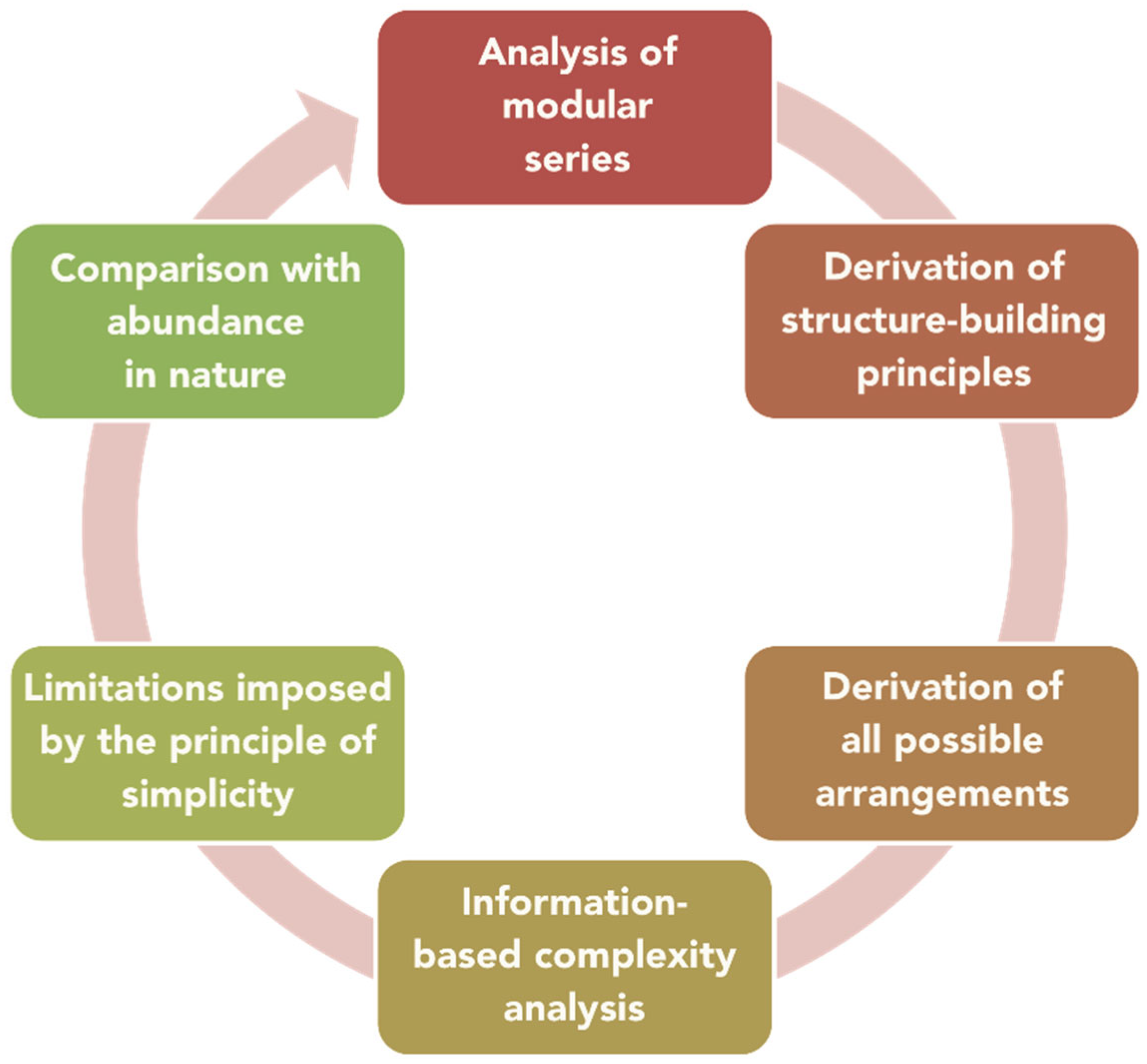
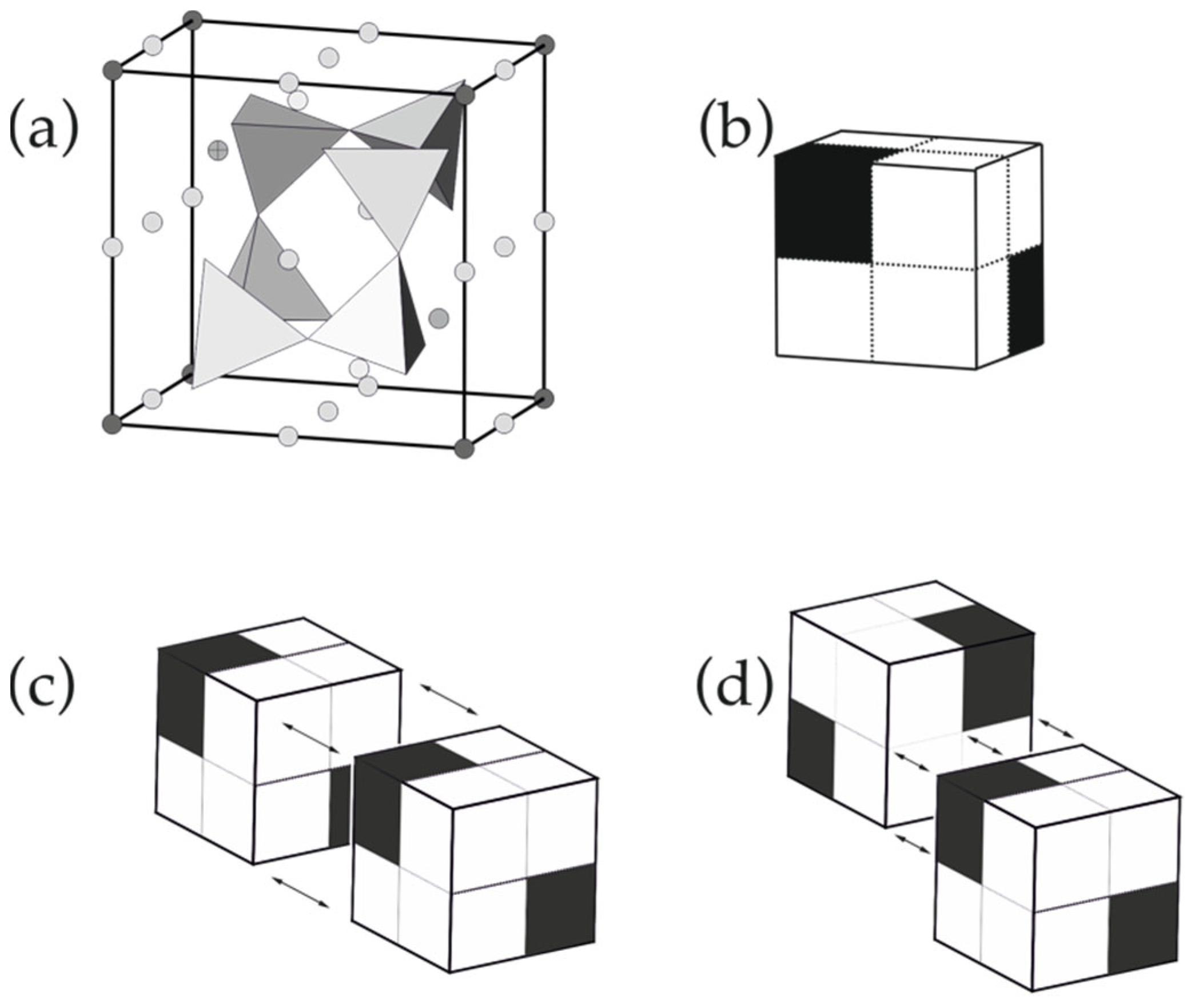
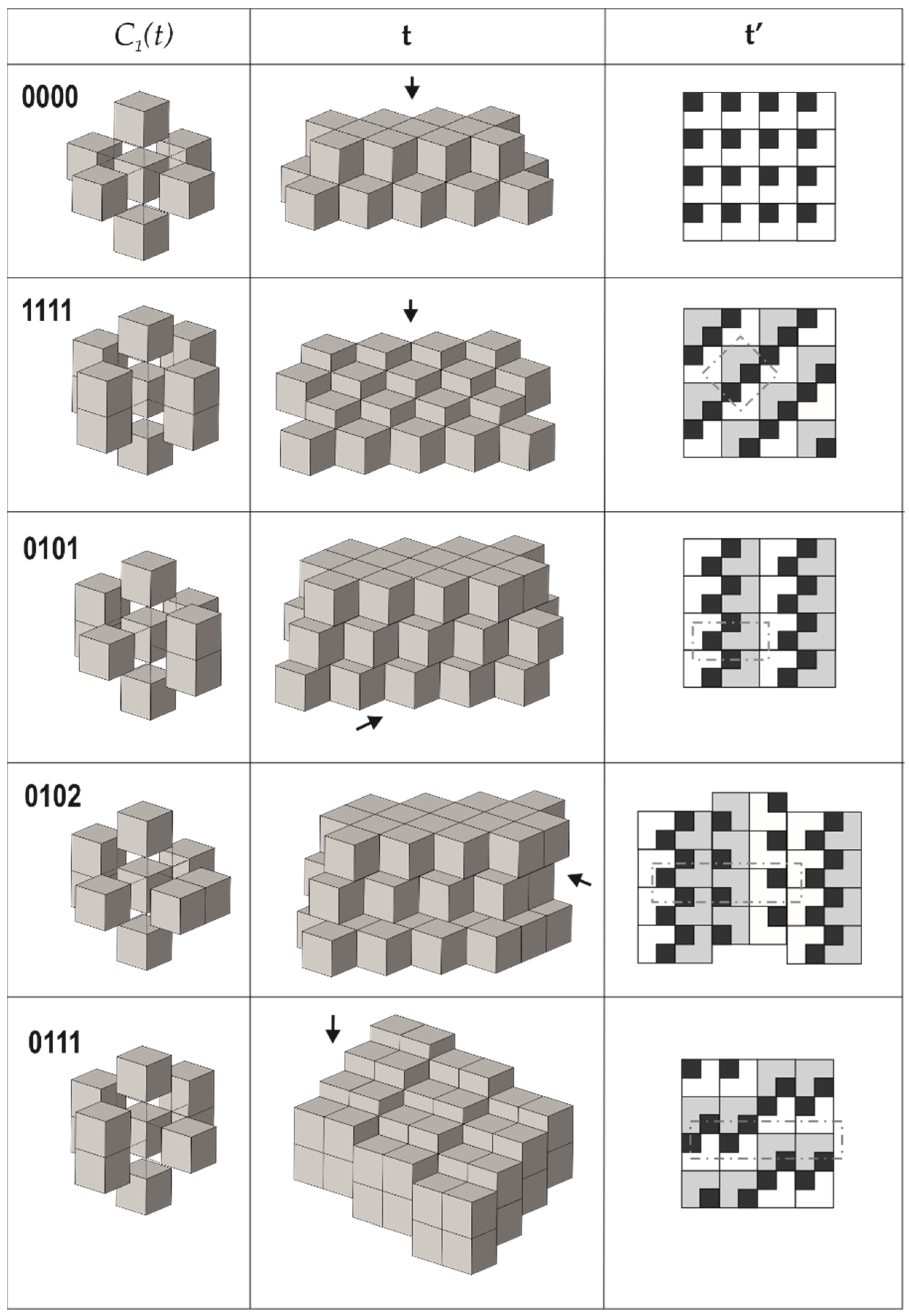
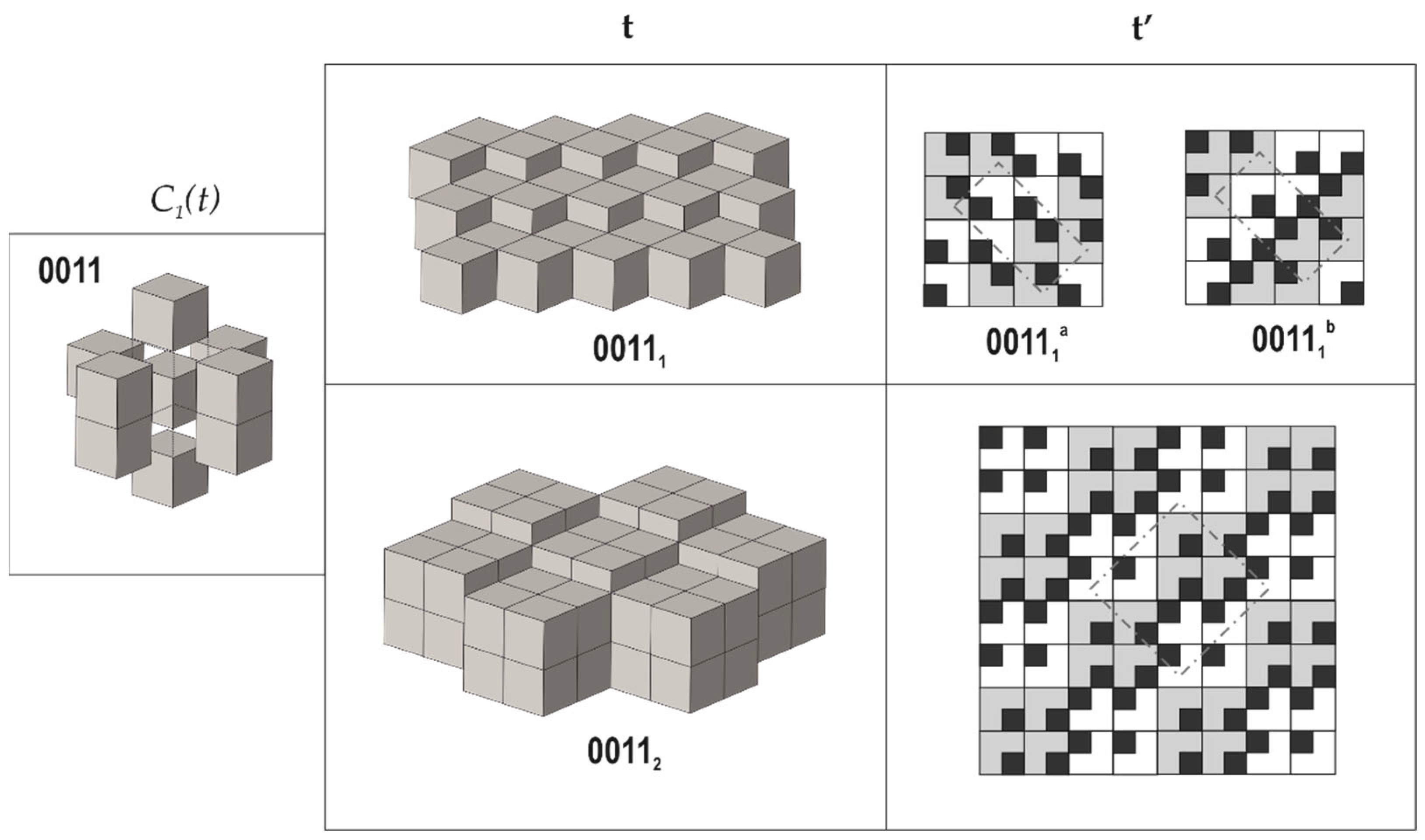


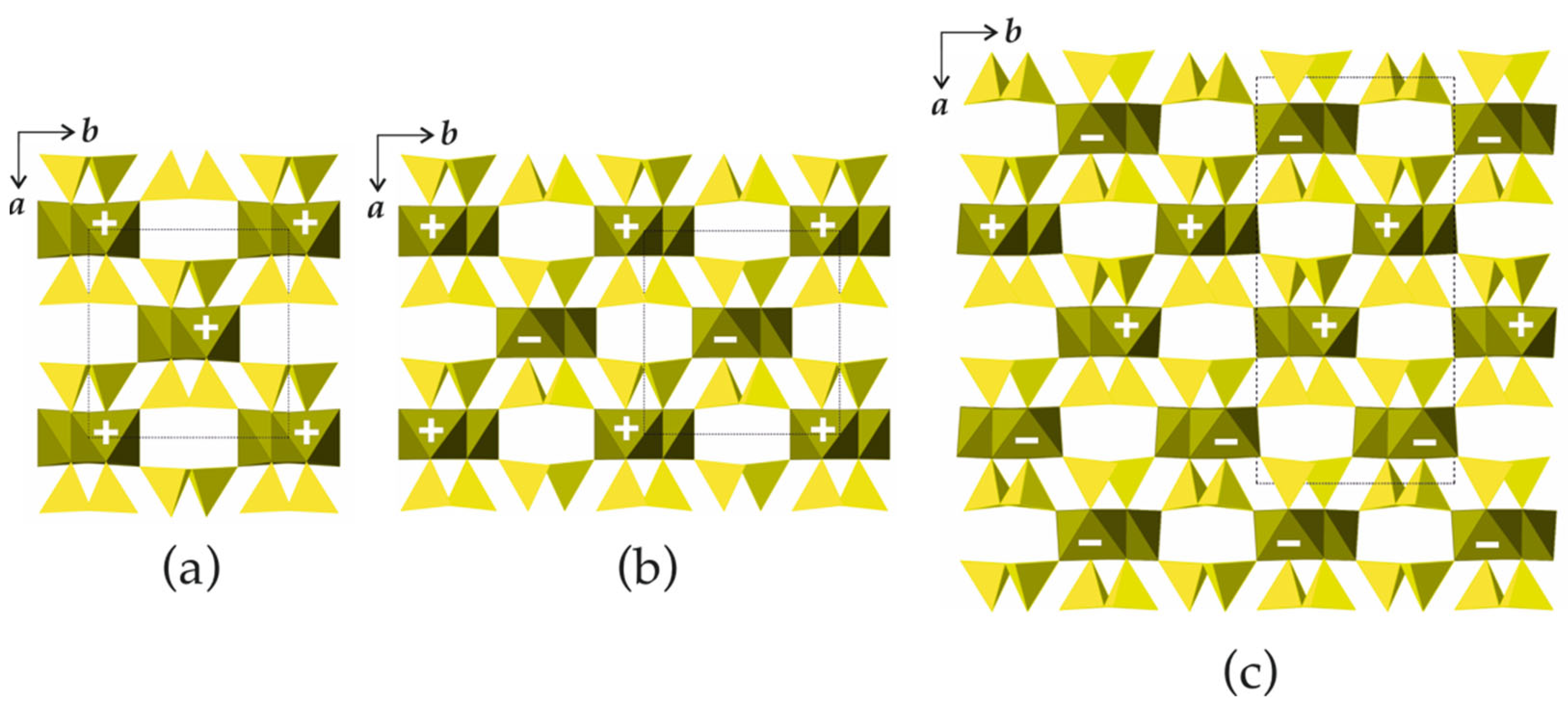
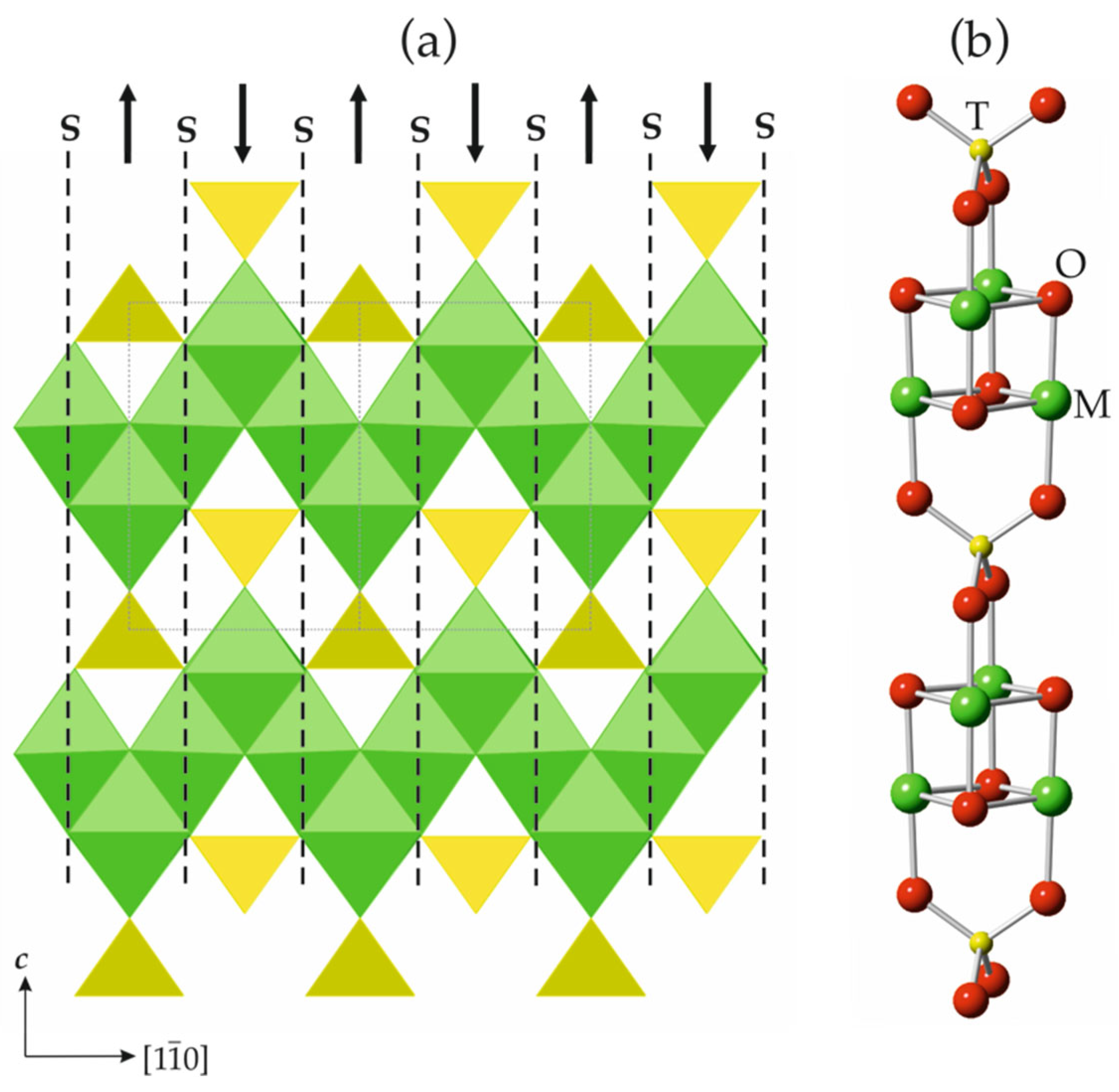



| Type | Space Group | Unit Cell 1 | strIG,total (Si + O) |
|---|---|---|---|
| 0000 | Rm | a × a × a | 48 |
| 1111 | Pmnn | 21/2a × 21/2a × a | 140 |
| 0101 | P21/c | a × a × 2a; β = 90o | 172 |
| 0102 | P41 | a × a × 4a | 440 |
| 0111 | B21/a | 2a × a × 2a; β = 90o | 440 |
| 00111a | Pbnn | 21/2a × 23/2a × a | 352 |
| 00111b | Pmnb | 21/2a × 23/2a × a | 368 |
| 00112 | Pnmn | 23/2a × 23/2a × a | 912 2 |
| 00011 | P21/c | a × a × 4a; β = 90o | 440 |
| 00012 | P4122 | a × a × 8a | 1072 |
| M | Space Group | Mineral Name | Chemical Formula | strIG,total |
|---|---|---|---|---|
| Monoclinic structure types with the (+) sequence | ||||
| 1 | C2/c | Diopside | CaMg(Si2O6) | 50 |
| 2 | C2/m | Tremolite | Ca2Mg5(Si4O11)2(OH)2 | 152 |
| 3 | C2/c | Clinojimthompsonite | Mg5(Si6O16)(OH)2 | 255 |
| Orthorhombic structure types with the (+ + – –) sequence | ||||
| 1 | Pbca | Enstatite | Mg2(Si2O6) | 266 |
| 2 | Pnma | Anthophyllite | Mg7(Si4O11)2(OH)2 | 743 |
| 3 | Pbca | Jimthompsonite | Mg5(Si6O16)(OH)2 | 1229 |
| Orthorhombic structure types with the (+ –) sequence | ||||
| 1 | Pbcn | Protoenstatite | Mg2(Si2O6) | 101 |
| 2 | Pnnm | Protoanthophyllite | Mg7(Si8O22)(OH)2 | 317 |
| Structure types with mixed M values | ||||
| 2, 3 | Cmc21 | Chesterite | Mg17(Si4O11)2(Si6O16)2(OH)6 | 1185 |
| Phase | OS | HS | n, m | Space Group | strIG,total (bits/Cell) | Example | Ref. |
|---|---|---|---|---|---|---|---|
| ε | (↑) | [T] | (1, 1) | Pmma | 35 | ε-Mg2SiO4 poirierite | [80] |
| I | (↑↑↑↓) | [T2S2] | (3, 1) | Pmma | 213 | (Ni10.3Al7.7)(Al3.6Si2.4)O32 | [81] |
| II | (↑↑↑↓↓↓) | [T2S]2 | (2, 1) | Imma | 141 | (Ni17Al7)(Al6.9Si5.1)O48 | [82] |
| III | (↑↑↓↓) | [TS]2 | (2, 2) | Imma | 79 | β-Mg2SiO4 wadsleyite | [83] |
| (2, 2) | Imma | 79 | β-Fe2SiO4 asimowite | [84] | |||
| IV | (↑↑↓↑↑↓↓↑↓↓) | [TS2TS]2 | (3, 2) | Imma | 279 | Ni3Al2SiO8 | [85] |
| Imma | 279 | Mg2SiO4 ‘wadsleyite II’ | [86] | ||||
| V | (↑↑↓) | [TS2] | (3, 3) | Pmma | 144 | Ni3Al2SiO8 | [87] |
| Spinel | (↑↓) | [S] | - | Fdm | 19 | γ-Mg2SiO4 ringwoodite | [88] |
| - | Fdm | 19 | γ-Fe2SiO4 ahrensite | [89] |
Publisher’s Note: MDPI stays neutral with regard to jurisdictional claims in published maps and institutional affiliations. |
© 2021 by the author. Licensee MDPI, Basel, Switzerland. This article is an open access article distributed under the terms and conditions of the Creative Commons Attribution (CC BY) license (https://creativecommons.org/licenses/by/4.0/).
Share and Cite
Krivovichev, S.V. The Principle of Maximal Simplicity for Modular Inorganic Crystal Structures. Crystals 2021, 11, 1472. https://doi.org/10.3390/cryst11121472
Krivovichev SV. The Principle of Maximal Simplicity for Modular Inorganic Crystal Structures. Crystals. 2021; 11(12):1472. https://doi.org/10.3390/cryst11121472
Chicago/Turabian StyleKrivovichev, Sergey V. 2021. "The Principle of Maximal Simplicity for Modular Inorganic Crystal Structures" Crystals 11, no. 12: 1472. https://doi.org/10.3390/cryst11121472
APA StyleKrivovichev, S. V. (2021). The Principle of Maximal Simplicity for Modular Inorganic Crystal Structures. Crystals, 11(12), 1472. https://doi.org/10.3390/cryst11121472






